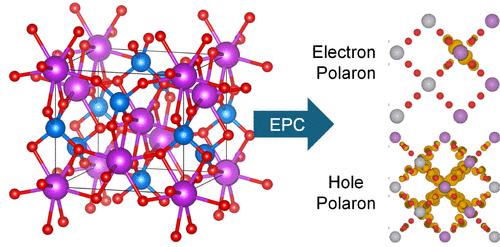钒酸铋多晶相极化子的第一性原理研究
IF 3.2
3区 化学
Q2 CHEMISTRY, PHYSICAL
引用次数: 0
摘要
钒酸铋(BiVO4)是一种很有前途的多晶态光催化剂,其性能受到载流子(极化子)行为的严重影响。虽然单斜晶型BiVO4中的极化子已被广泛研究,但对其主要晶相(包括单斜晶型白钨矿、四方锆石型白钨矿和四方晶型白钨矿)的极化子行为的比较理解对于优化光催化效率至关重要。本研究采用从头计算方法系统地研究了这三种BiVO4相中的电子极化子和空穴极化子。我们发现了不同的极化子特征:电子极化子始终被确定为荷尔斯坦型,而空穴极化子在所有三种晶体结构中都是Fröhlich型。我们的分析表明,尽管所有相中的空穴都被大约30 meV的纵向光学声子散射,但散射强度的变化导致了空穴迁移率的不同。通过对介电张量和玻恩有效电荷的分析,阐明了迁移率差异的微观根源。这项工作揭示了晶体结构调节极化子性质的机制,为设计高效的bivo4基光功能材料提供了重要的理论指导。本文章由计算机程序翻译,如有差异,请以英文原文为准。

First-Principles Study of Polarons in Multiple Crystal Phases of Bismuth Vanadate
Bismuth vanadate (BiVO4) is a promising photocatalyst existing in multiple crystal phases, whose performance is critically influenced by charge carrier (polaron) behavior. Although polarons in monoclinic BiVO4 have been extensively studied, a comparative understanding of polaron behavior in its main crystal phases, including monoclinic scheelite, tetragonal zircon type, and tetragonal scheelite, is essential for optimizing photocatalytic efficiency. This study systematically investigates electron and hole polarons in these three BiVO4 phases using ab initio calculations. We find distinct polaron characteristics: electron polarons are consistently identified as Holstein type, whereas hole polarons are of the Fröhlich type in all three crystal structures. Our analysis reveals that although holes in all phases are scattered by longitudinal optical phonons of approximately 30 meV, variations in scattering strength lead to differing hole mobilities. The microscopic origins of these mobility differences are elucidated through analysis of dielectric tensors and Born effective charges. This work uncovers the mechanism by which crystal structure modulates polaron properties, offering crucial theoretical guidance for designing high-efficiency BiVO4-based photofunctional materials.
求助全文
通过发布文献求助,成功后即可免费获取论文全文。
去求助
来源期刊

The Journal of Physical Chemistry C
化学-材料科学:综合
CiteScore
6.50
自引率
8.10%
发文量
2047
审稿时长
1.8 months
期刊介绍:
The Journal of Physical Chemistry A/B/C is devoted to reporting new and original experimental and theoretical basic research of interest to physical chemists, biophysical chemists, and chemical physicists.
 求助内容:
求助内容: 应助结果提醒方式:
应助结果提醒方式:


